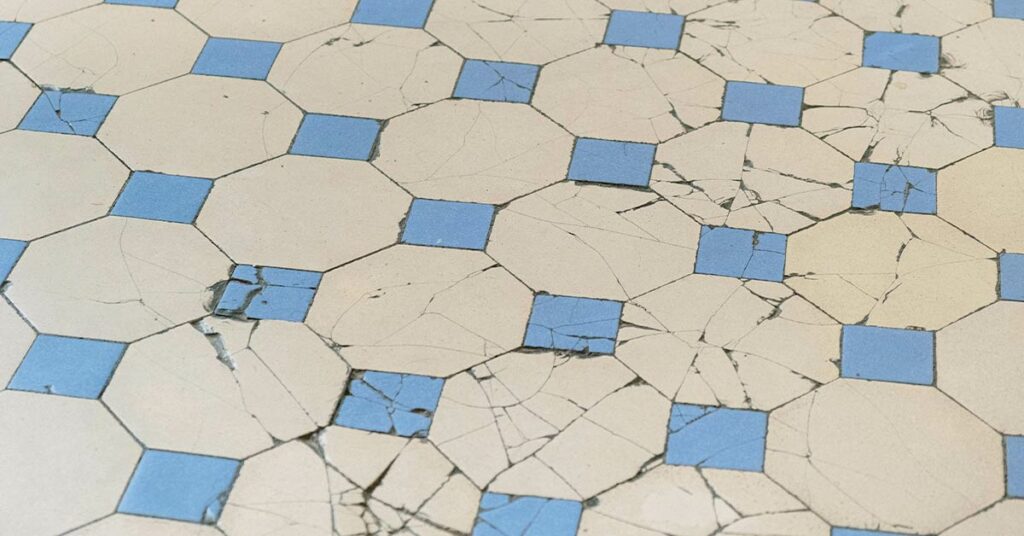
Properly installed tile floors and surfaces are known for their enduring elegance. But here’s the twist – sometimes people who ought to replace their tile don’t, and sometimes people have their tile replaced unnecessarily. If you’re trying to decide whether to repair and restore your tile or to have it all taken out and start fresh, this article explores key considerations.
Tile is a floor and surface covering material that has been around for thousands of years. Throughout history, ancient craftspeople would meticulously repair or replace damaged handmade tiles whenever earthquakes, fires, or general use and wear took a toll. With the advent of mass tile production and specialized tools, as well as modern advancements like adhesives, fillers, and coatings, tile repair and restoration solutions have become more accessible than ever. Today, homeowners have plenty of options when it comes to preserving existing tile installations and virtually limitless options for brand-new ones.
Tile Repair and Restoration
Tile repair and restoration rather than replacement may be possible in some circumstances. Let’s look at tile failures compared to problems or aesthetic concerns that can be resolved.
Tile Failures
There is a general consensus among industry professionals that a tile installation should be replaced rather than repaired when there are major problems. Here are some examples:
- Debonding or delamination happens when the tile has separated from the substrate. Improper installation methods or inappropriate setting materials may be a cause, but there are many other possible causes, including substrate movement and water damage. If debonding is isolated in a small area, repair may be possible, but if the problem is widespread, you’ll likely need to replace the entire installation.
- Tenting happens when tiles lift along a grout joint and form the shape of a tent while remaining attached to neighboring grout joints. Tenting is caused by improper installation, specifically, a lack of expansion joints around the edges of the room. Tile must be able to expand and contract. If it can’t, it lifts. If tiles are tenting, you’ll need to have the installation replaced.
- Cracking that looks like a long, continuous crack going across a series of tiles from one end of the room to the other is different from an isolated crack here or there. Without going into all of the technical details, chances are if you see this type of crack, you are dealing with a bigger problem hidden underneath the tile.
- Substrate problems may or may not require a full tile replacement. It depends on the extent of damage and the type of substrate. No matter what, a successful tile installation requires a stable base. If substrate repairs can be accomplished without removing too many tiles and enough replacement tiles are available for repairing the affected area, it may be possible to avoid a full demo and reinstallation.
Aesthetic Concerns
Cracks
Tile cracks can be repaired, but too many cracks may be a sign of an underlying problem that will only get worse as time goes on. If you can identify the cause of cracks, for example, if something heavy was accidentally dropped, then you can have the individual tiles repaired or replaced. After that, you can avoid further damage.
Chips
A little chip here and there is no big deal. Restoration contractors can use tinted fillers to repair the damage. After that, just avoid situations where tiles are exposed to force or impact.
As with cracks, excessive chip damage may indicate an underlying problem. For example, if tiles are unevenly laid so that some tiles are a little higher or lower than neighboring tiles, chips can result. Repairing the chips would only be a temporary fix in a situation like this. The exception is that certain types of tiles, such as natural stone, can be ground down so that the surface is flat (this is called lippage removal), which would resolve ongoing problems with chip damage.
Signs of Wear
A skilled tile and stone repair and restoration contractor can dramatically improve the appearance of most tile floors and surfaces, especially when the material is natural stone. However, certain types of materials, for example, high-gloss glazed ceramic tiles, can be difficult or impossible to repair and restore to like new condition. Homeowners will either need to accept the imperfections or replace material.
Structural Renovation
During major renovation projects, tile damage may be unavoidable. In certain situations, such as removing walls, a creative contractor can find a tasteful and artistic way to disguise damage. Salvaging your existing installation may be more trouble than it’s worth. Discuss the possibilities with your contractor.
Maintenance
Whether you purchased a home with high-maintenance floors and surfaces already in place or made an unfortunate material selection decision, you may find that maintaining the appearance of your tile is too difficult or time consuming. One example would be polished marble tile floors in a high-traffic kitchen or bathroom. Within weeks, or even days, signs of wear would be evident.
Before you replace your high-maintenance tile, you might want to reach out to a reputable tile restoration contractor, such as Rock Solid Restoration or Stoneworks. Ask about anti-etch treatments, high-performance coatings, or other solutions that might reduce the burden of maintenance.
Tile Replacement: Brand New Tile
For a variety of reasons, homeowners often choose to replace existing tile installations that, from a functional perspective, still have plenty of life. Whether you have purchased a home with tile that isn’t your style, you want to keep up with the latest tile trends, or it’s just time for a change, a brand new tile installation may be one of the most satisfying decisions you make as a homeowner. Before you make any big decisions about your new tile project, here are a few things to consider:
- Choose high-quality tile that is appropriate for its intended use. For example, if you love the look of polished marble tiles and you are doing a kitchen renovation, use this material for a countertop-to-ceiling backsplash instead of having it installed on the kitchen floor where it will be exposed to more traffic and use.
- Choose tile that is easy to maintain, unless you don’t mind the extra effort or can afford to pay for a cleaning service. Be aware that patterned tiles, intricately designed tiles, tiles with irregular shapes, and textured tile surfaces can be more difficult to maintain.
- If you want a tile installation that can be restored to like-new condition decades after installation, choose natural stone. Even if stone has extensive surface damage, in most cases, it can be honed and polished to showroom-ready perfection.
- Always purchase extra replacement tiles when you are ordering materials for your new project. If you wait until later, tile might be discontinued. Even if your brand, style, and color of tile is still available, there may be variation from one lot to the next. This is especially true of natural stone and decorative or custom tile. Talk to your installer about how much extra tile you should purchase, just in case.
- Do your due diligence when it comes to hiring a tile installation contractor. Ask about certifications, training, professional affiliations, experience, and warranties or guarantees. Read online reviews and peruse contractor’s websites.
Proper Cleaning and Care
Certain tile cleaning and care mistakes can lead to the need for repair and restoration services. Whether you’re keeping an existing installation or having new tile installed, proper cleaning and care can make a big difference in the appearance and longevity of your tile floors and surfaces.
Here are a few quick tips for avoiding problems:
- Use appropriate cleaners and avoid harsh chemicals and abrasives.
- Clean spots and spills before they turn into permanent stains and use stain removal poultices, as needed.
- To minimize wear associated with abrasive contaminants brought in by pets or on shoe soles, sweep regularly, spot-mop as needed, and use high-quality walk-off mats at entrances.
- Preventative measures, such as sealing tile and grout or applying anti-etch treatments or high-performance coatings may be appropriate, depending on the material.
Want to learn more about tile cleaning and care, including how to mix and apply a poultice for stain removal? Read our article, “How Do I Keep My Tile Looking New After Installation?”
Tile is a long-term investment, and as such, choosing whether to repair or replace tile may not be an easy decision. It’s all about understanding when a little tile makeover will suffice or when it’s time to be adventurous and go all in on a brand new tile installation. We’re here for you if you are ready to discuss new tile possibilities. Our skillfully installed tile projects can provide decades of use and enjoyment.
Related reading: What Happens If Water Gets Under My Tile Floor?
by Alice Dean
Copher Tile & Stone proudly stays up to date on tile floor installation with ongoing education with Mapei Technical Institute, Ardex Academy, the National Tile Contractors Association, Laticrete, and Schluter. Copher is a Certified Tile Installer (#1644).

